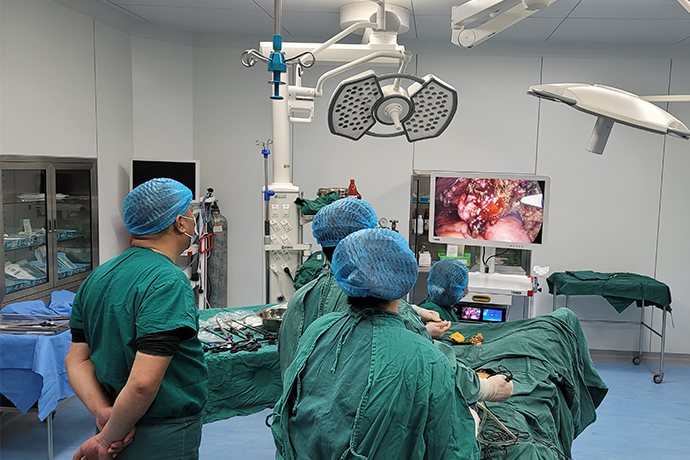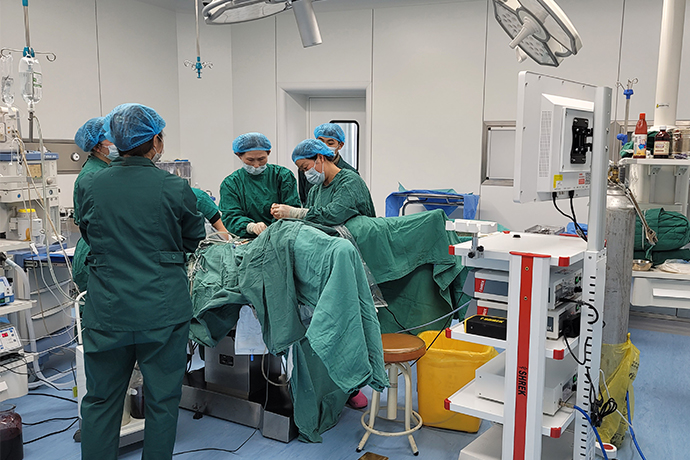【Thoracoscopy】Treatment skills of the first branch of the left pulmonary artery
Release time: 01 Feb 2021 Author:Shrek
Among the five lobectomy operations in humans, the removal of the left upper lobe has always been considered the most difficult. The reason is that the management of the first main branch of the left pulmonary artery (also known as the upper trunk of the left pulmonary artery) is often difficult and risky. This article summarizes some experiences on this issue.

1. The number of branches is variable.
Due to the complex composition of the upper trunk of the left pulmonary artery, the number of branches varies. Sometimes it is only one type, sometimes it can be more types. In the process of severing, pay attention to thoroughly recognize the number, and occasionally there will be small branches that are easy to be ignored. This needs to be viewed separately from the front and rear. In particular, the mediastinal branch of the lingual artery has a downward and horizontal course, so be careful not to miss the injury.
2. Often blocked by the upper left pulmonary vein.
The treatment of the upper trunk of the left pulmonary artery generally requires cutting off the left upper pulmonary vein first, because it is often blocked by the vein below. This is different from other lobectomy procedures.
Because it is necessary to cut the veins in advance, in order to minimize pulmonary congestion, the other arterial branches of the left upper lobe are generally processed first, and then the veins are cut off, and then the upper trunk of the left pulmonary artery is processed.
3. It is not easy to expose, and it spans the front and back views.
The upper trunk of the left pulmonary artery is located at the top and at the junction of the mediastinal pleura before and after the hilum, so it is not easy to expose. The exposure of the anterior and posterior edges of the artery spans two fields of view. It needs to be dissected separately from the front and back to completely dissociate it completely. It is not possible to blindly dissociate just after dissociating the front, because it may damage the unseen branches behind.
The upper trunk of the left pulmonary artery is dissected and exposed.
4. The branch is short and the angle with the pulmonary artery is acute.
The upper trunk branch of the left pulmonary artery is very short, and they enter the lung very early. Moreover, the angle between the arterial branch and the pulmonary artery trunk is an acute angle, so it is easy to be torn and bleed, which is the primary reason for its difficulty in handling.
The artery should be freed as far as possible to expand the vascular clamp space. The pulling direction of the lung should not be too downward, and the angle of the artery branch and the pulmonary artery should be increased as much as possible.
When the vascular clamp is separated, it should be ensured that there is no tension at the bifurcation, because it has encountered multiple tears and bleeding at the bifurcation. Do not force separation when there is insufficient space, otherwise it may cause bleeding. Once bleeding, first use compression to stop the bleeding, in most cases it will be suppressed.
5. The branch is close to the root of the pulmonary artery. Once the bleeding is difficult to control, the risk is greater.
The left pulmonary artery branches out the first branch after a short distance from the pericardium. Therefore, once bleeding from the first branch is difficult to control. It is necessary to predict the condition of the upper trunk of the left pulmonary artery and decide whether to pre-block the trunk of the left pulmonary artery.
A safer approach is to estimate that the first branch is risky. The left pulmonary artery can be freed from the trunk near the pericardium. At the same time, the interlobular trunk of the pulmonary artery can be freed to prepare for blocking at any time. Blocking can be done with a pug vascular clip, or with a silk thread through a tube. When blocking, the anesthesiologist should be asked to closely observe the patient's heart rate, heart rhythm, blood pressure and other conditions.


1. The number of branches is variable.
Due to the complex composition of the upper trunk of the left pulmonary artery, the number of branches varies. Sometimes it is only one type, sometimes it can be more types. In the process of severing, pay attention to thoroughly recognize the number, and occasionally there will be small branches that are easy to be ignored. This needs to be viewed separately from the front and rear. In particular, the mediastinal branch of the lingual artery has a downward and horizontal course, so be careful not to miss the injury.
2. Often blocked by the upper left pulmonary vein.
The treatment of the upper trunk of the left pulmonary artery generally requires cutting off the left upper pulmonary vein first, because it is often blocked by the vein below. This is different from other lobectomy procedures.
Because it is necessary to cut the veins in advance, in order to minimize pulmonary congestion, the other arterial branches of the left upper lobe are generally processed first, and then the veins are cut off, and then the upper trunk of the left pulmonary artery is processed.
3. It is not easy to expose, and it spans the front and back views.
The upper trunk of the left pulmonary artery is located at the top and at the junction of the mediastinal pleura before and after the hilum, so it is not easy to expose. The exposure of the anterior and posterior edges of the artery spans two fields of view. It needs to be dissected separately from the front and back to completely dissociate it completely. It is not possible to blindly dissociate just after dissociating the front, because it may damage the unseen branches behind.
The upper trunk of the left pulmonary artery is dissected and exposed.
4. The branch is short and the angle with the pulmonary artery is acute.
The upper trunk branch of the left pulmonary artery is very short, and they enter the lung very early. Moreover, the angle between the arterial branch and the pulmonary artery trunk is an acute angle, so it is easy to be torn and bleed, which is the primary reason for its difficulty in handling.
The artery should be freed as far as possible to expand the vascular clamp space. The pulling direction of the lung should not be too downward, and the angle of the artery branch and the pulmonary artery should be increased as much as possible.
When the vascular clamp is separated, it should be ensured that there is no tension at the bifurcation, because it has encountered multiple tears and bleeding at the bifurcation. Do not force separation when there is insufficient space, otherwise it may cause bleeding. Once bleeding, first use compression to stop the bleeding, in most cases it will be suppressed.
5. The branch is close to the root of the pulmonary artery. Once the bleeding is difficult to control, the risk is greater.
The left pulmonary artery branches out the first branch after a short distance from the pericardium. Therefore, once bleeding from the first branch is difficult to control. It is necessary to predict the condition of the upper trunk of the left pulmonary artery and decide whether to pre-block the trunk of the left pulmonary artery.
A safer approach is to estimate that the first branch is risky. The left pulmonary artery can be freed from the trunk near the pericardium. At the same time, the interlobular trunk of the pulmonary artery can be freed to prepare for blocking at any time. Blocking can be done with a pug vascular clip, or with a silk thread through a tube. When blocking, the anesthesiologist should be asked to closely observe the patient's heart rate, heart rhythm, blood pressure and other conditions.

- Recommended news
- 【General Surgery Laparoscopy】Cholecystectomy
- Surgery Steps of Hysteroscopy for Intrauterine Adhesion
- [Gynecological Hysteroscopy] Techniques for Preventing and Treating Complications of Hysteroscopic Surgery
- [Gynecological Hysteroscopy] Hysteroscopic Adhesiolysis
- [Gynecological Hysteroscopy] IUD Removal under Hysteroscopy